
Ercolano is a commune and city located in southern Italy, in the Campania region, on the shores of the Gulf of Naples, 10 kilometers from the historic center of Naples and 16 kilometers from Pompeii, between the cities of Portici and Torre del Greco.
The medieval town of Resina (now Ercolano) was built on the volcanic material left after the eruption of Vesuvius in 79 ad that destroyed the ancient city of Herculaneum, from which the name - Ercolano, officially received by the city in 1969 and is the Italian version of the ancient name of Ercolano (Herculaneum).
Currently Ercolano is a small town and the suburban resort of Naples, an area of about 20 square kilometers with a population of just over 53 thousand people.
Ercolano is popular with tourists, primarily due to the fact,
- what is the starting point for the ascent of Vesuvius by bus-Express. Office buses (Vesuvio Espress) is in Piazza Stazione (Piazzale Stazione 80056 Ercolano), near the train station Ercolano scavi Herculaneum (Ercolano Scavi). The cost of the return ticket is 10 Euro + 10 Euro ticket to visit the crater (optional). Half price for children up to 6 years. Site of Express buses. The office operates a tourist information centre where you can take a map of attractions Ercolano.

Also in Ercolano, on the street 4 Nov (Via IV Novembre) are minibuses, which for 10 Euros you can climb the Vesuvius. Car Park 1 hour 30 minutes to mount Vesuvius + on the road about an hour.
Attention! Ticket prices and conditions may change, please check before visiting.
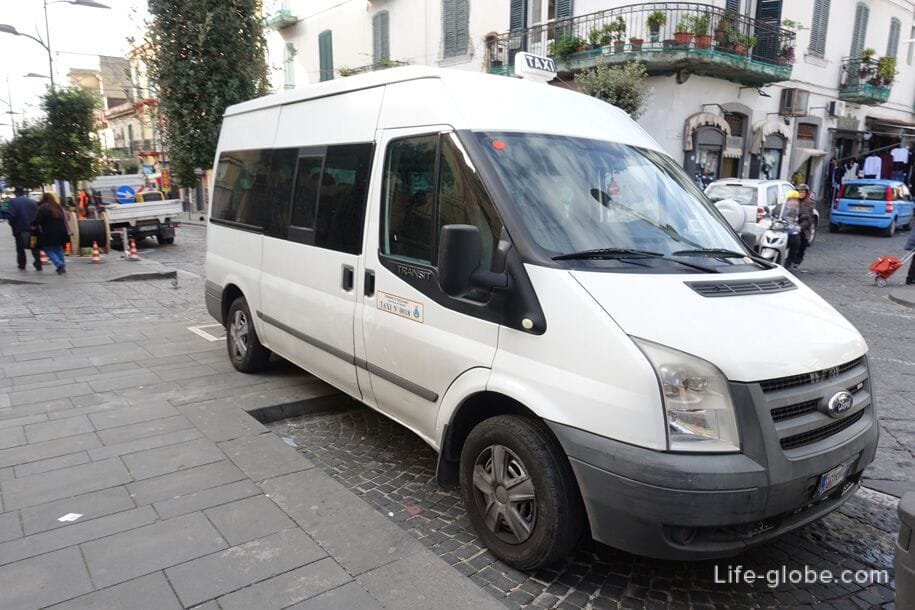
- the city is the archaeological Park of Herculaneum, which is one of the few ancient cities, preserved more or less intact, without significant modifications.
Today, the Park Herculaneum, along with Pompeii, a UNESCO world heritage site. However, unlike Pompeii, Herculaneum is a pretty small area, but not less important, with its urban appearance, an old civilization and, more valuable, with its "human face". In the archaeological Park of Herculaneum is located a few streets on both sides of which the remains of houses and villas, shops and public baths. Also, the remains of the market square fountains, the palestra and boat sheds with the skeletons of the dead inside. Read more about the archaeological Park of Herculaneum...



The main street of Ercolano acts via Vittorio Veneto (Via Vittorio Veneto), smoothly flowing in the street on 4 November, on which a fountain, cafes and small shops. These streets lead from the railway station of Ercolano scavi archaeological area of Herculaneum.
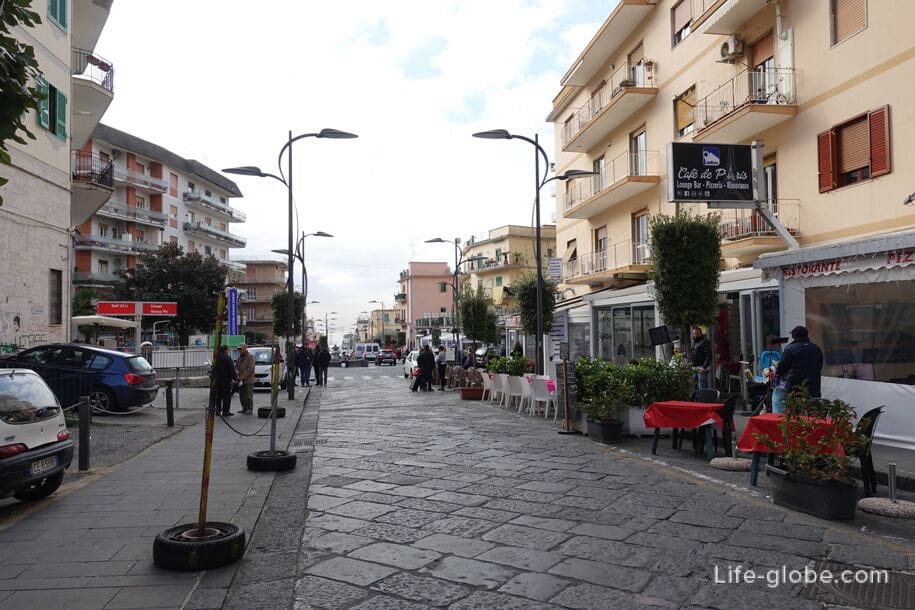

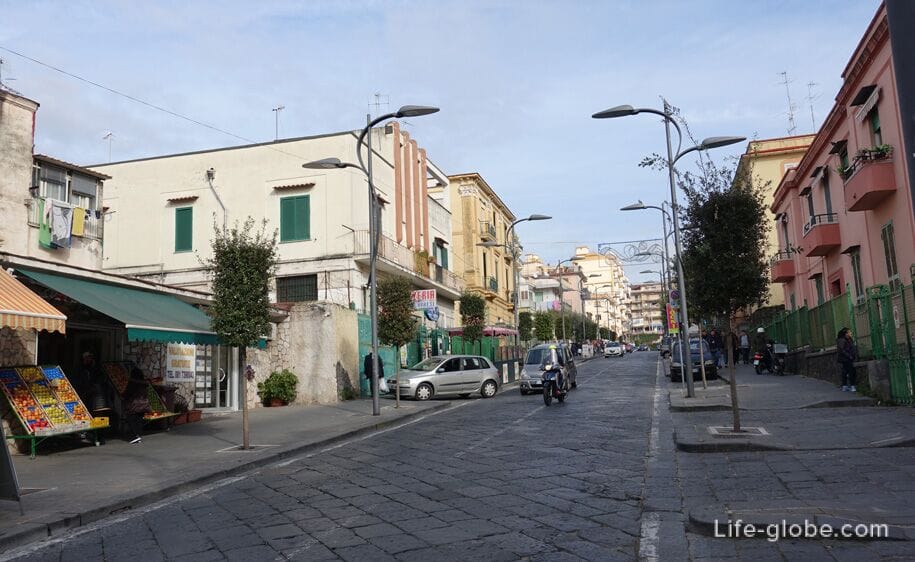

The town has several churches, the chief and oldest of which is the Papal Basilica of Santa Maria Pullano or Basilica of St Mary Pullano (Basilica Santa Maria A Pugliano). The Church is located on the homonymous square (Piazza Pugliano).
The Church contains two pagan marble sarcophagus of the 2nd and 4th centuries of our era, adapted to the Christian altars, probably in the 11th century. The Church is notable for the massive 36-metre high bell tower of the late 16th century, the main altar with a wooden statue of the Madonna di Pullano and the Crucifix of the 14th century.
The patron of the commune is the virgin Mary, August 15 is celebrated on a particularly Holy day assumption of the blessed virgin.
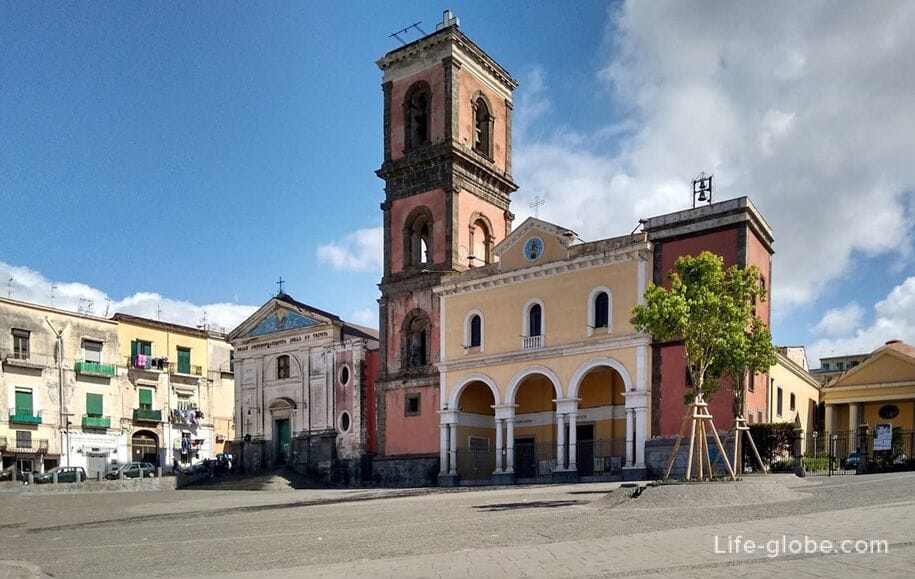
In the immediate vicinity of the square, on the street Pullano (Via Pugliano) there are shops and a street market resin (mercato di Pugliano / mercato di Resina / Vintage market area).

The Virtual archaeological Museum (Museo Archeologico Virtuale) opened in 2005, in order a multimedia approach to the story, showing the lifestyle and habits of ancient Herculaneum, and the tragic events of the eruption of Vesuvius in 79.
The Museum building was built in the late 1920-ies as a covered food market. A few years later, the market was converted into a school and operated until 1980, until he suffered from a strong earthquake, then the building was abandoned. After many years of complete neglect, at the beginning of the new century, the city Council fully restored the building and turned into a multipurpose cultural centre, which includes a Museum, bookstore and theater that seats 300.
Address: Via IV Novembre 44, Ercolano, Italy.
The cost of entry: visit a Museum and 3D movie - € 10 adults, €8 children under 13, people over 65 and students.
The operation of the Museumfrom March 1 to may 31 - daily from 9:00 to 17:30 (last entry); 1 June-30 September every day from 10:00 to 18:30 (last admission); from 1 October to 28 February - from Tuesday to Sunday from 10:00 to 16:00 (last admission).
Attention! Admission and mode of operation of the Museum may vary, please check before visiting. Site.
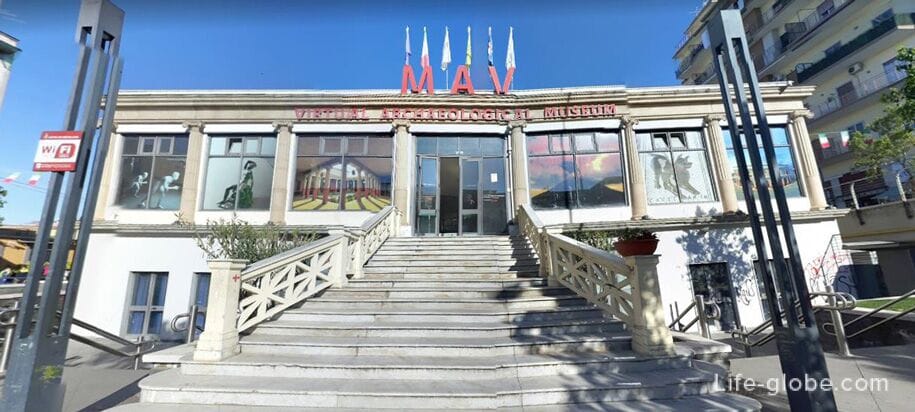
Golden mile Ercolano (Miglio d'oro) - Corso Resina (Corso Resina), the young girl who leads from the archaeological Park of Herculaneum in the direction of Torre del Greco (Torre del Greco).
In this place built the largest and most luxurious villas of the city, designed by the best architects of the past and built in the 18th century noble families of the Kingdom of Naples near the Royal Palace of Portici. Many of the villas was rear gardens and forests, some of which could compete with the Royal palaces. It is estimated in Ercolano was 121 Villa of the 18th-19th centuries.
In 1997, the Golden mile, along with the Vesuvius was included in the World network of biosphere reserves under the UNESCO programme "Man and biosphere reserve".
The most famous villas are:
- April Villa (villa Aprile) also known as Villa Riario Sforza (Villa Riario Sforza) in honor of the first owner who built it in the second half of the 18th century. It is among the largest villas of the Miglio d'oro and still retains one of the most elegant parks.
Since 1879, the Villa belonged to the family of Aprilia. After decades of dilapidated Villa and its Park were purchased and converted into a 4-star hotel Miglio d'oro Park Hotel. In the room price included Breakfast which is served in the elegant dining room of the 18th century, and in the evening guests can enjoy a romantic candlelit dinner in the Park area adjacent to the restaurant. In the Park of the hotel there are marble sculptures, fountains and pond;

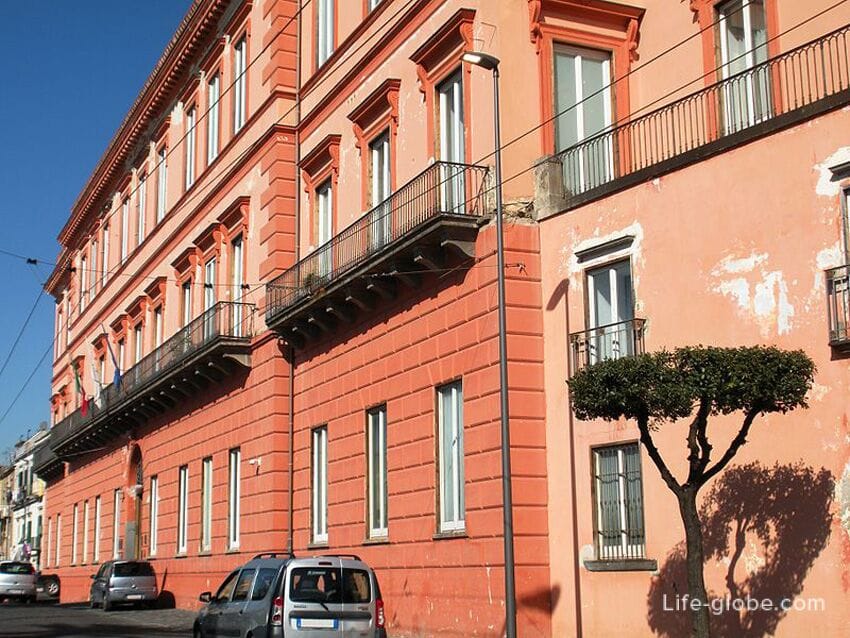
Villa Tosti di Valmanera (villa di Tosti Valmanuta) 18th century;
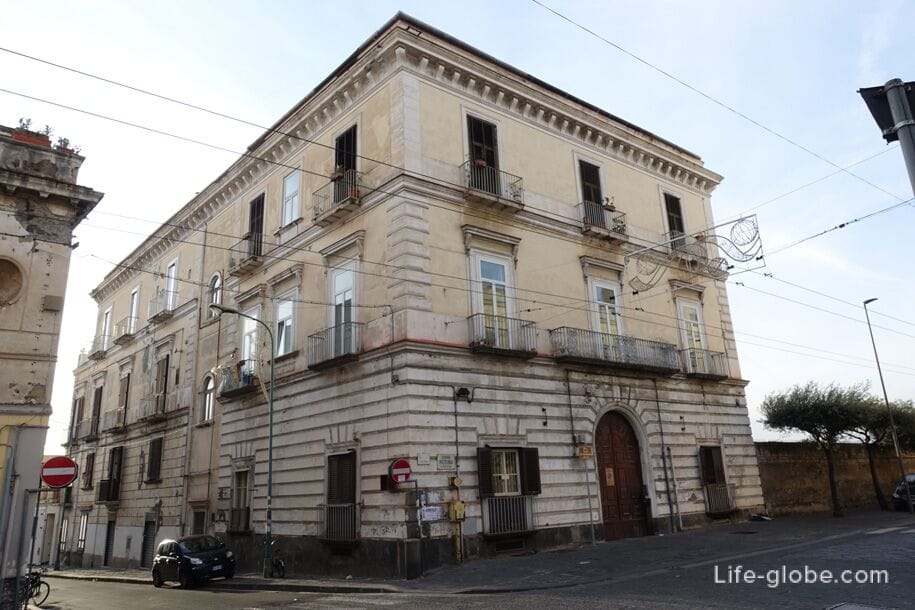
- Campolieto Villa (villa Campolieto), built in 1755 by the project of Luigi Vanvitelli, the architect of the Royal Palace of Caserta. Though austere and simple facade from the street side, the inner side of the Villa facing the sea, offers a magnificent elliptic Exedra with a continuous arcade, which also performs the functions of the Belvedere in the direction of the Gulf of Naples.
Stairs leading to the upper floor of the Villa, is one of the most monumental private buildings of the city - it is surrounded by large Windows and reminiscent of a Royal Palace of Caserta. In the ground floor rooms have original paintings and decoration of Jacopo Cestaro,, Fedele Fisette and Gaetano Magri.
The Villa is Campolieto the Executive office of Fondazione Ente Ville Vesuviane and The School Management Stoà. Also inside the Villa are open for exhibitions, conferences, fairs and festivals. The Villa has a garden;
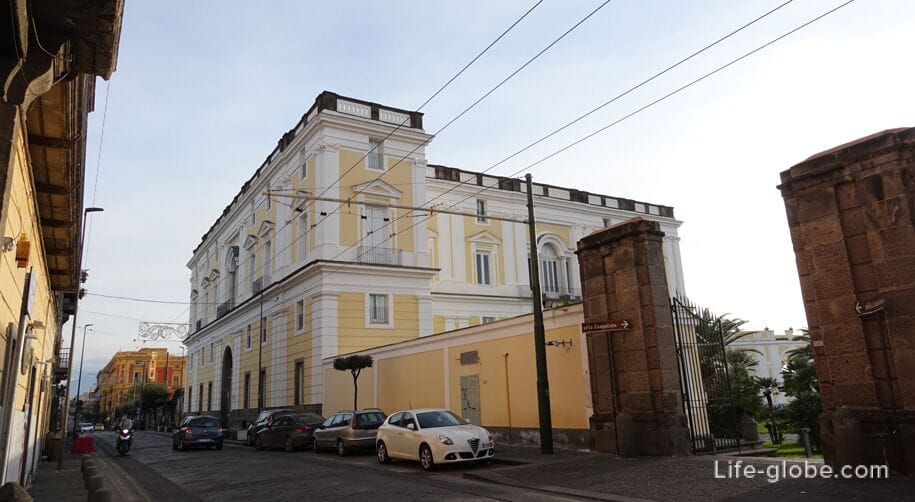

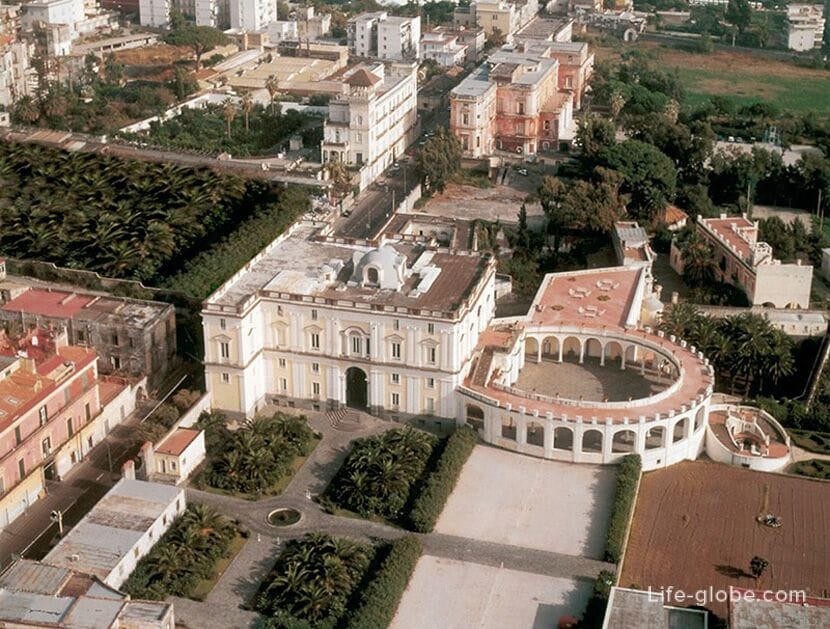
Villa Battista (Battista villa) 19th century. Currently, the walls of the Villa there is the hotel "bed and Breakfast" Villa Battista with free Wi-Fi, a restaurant and rooms with air conditioning. Room rates include Breakfast;
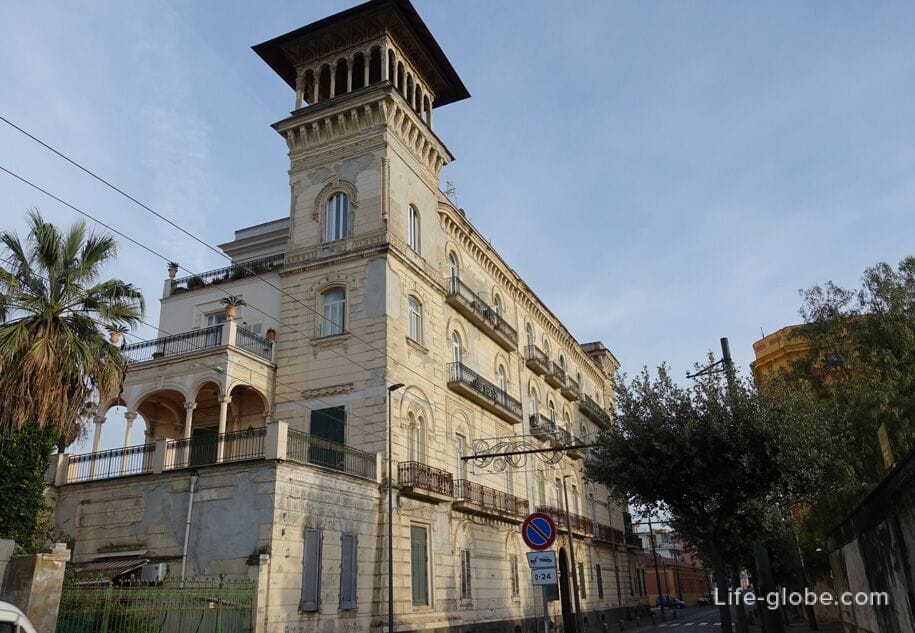
- Villa Favorita (villa Favorita), designed by architect Ferdinando Fuga in 1762 for the Principe di Hacks and di Campofiorito, who bought and restored a pre-existing smaller building. In 1768 the Prince has arranged a lavish party in honor of king Ferdinand of Bourbon and his wife Maria Carolina of Augsburg, who has just arrived from Vienna. The Queen liked the Villa, which reminded her of Vienna's schönbrunn Palace and since then the Villa is called "Favorite" (favorite). In 1792 the Villa annexed to the ownership of the Crown, and the king bought nearby land from the sea to create a large Park from the main building on the street to the sea and a dock for boat access. The residence was often used by the Royal couple and their children. The second son of king Leopoldo of Bourbon, having lived there, expanded the Palace and built several pavilions for entertainment and recreation. From 1879 to 1885, Villa Favorita was taken by Ismail Pasha, ex-Khedive of Egypt, who decorated the interiors of their rooms in the Moorish style and built in the Park, Moorish pavilion.
In the 20th century the Park was divided into two parts: the Palace from the upper Park was used as a military facility and a lovely Park (Parco sul Mare della Villa Favorita) was used as a plot of land and after the earthquake of 1980 was requisitioned by the City Council for the temporary accommodation of the evacuated families.
In the nineties the Foundation of the Ente per le Ville Vesuviane purchased and restored the lower section of the pavilions and pier and now uses it for exhibitions, concerts and other events.
The main building on Corso Resina different double court and the magnificent semicircular staircase on the back side, which connects the main ground floor hall with the Park. The facade was recently restored.
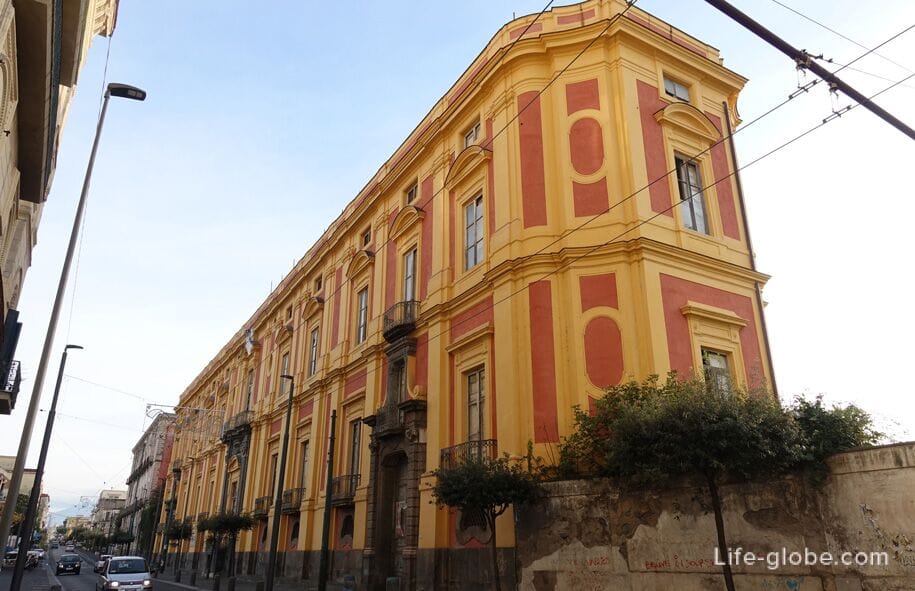
Photos of Corso Resina


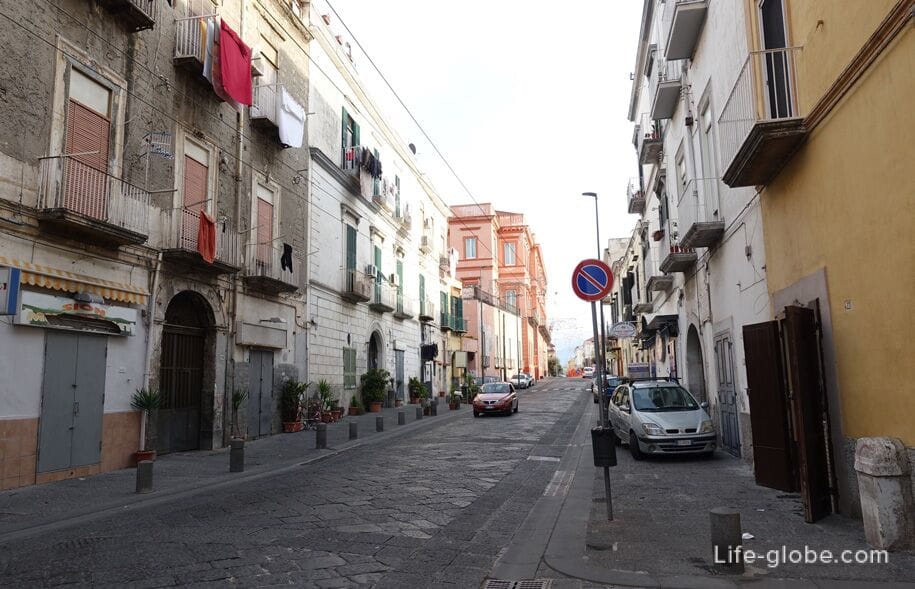

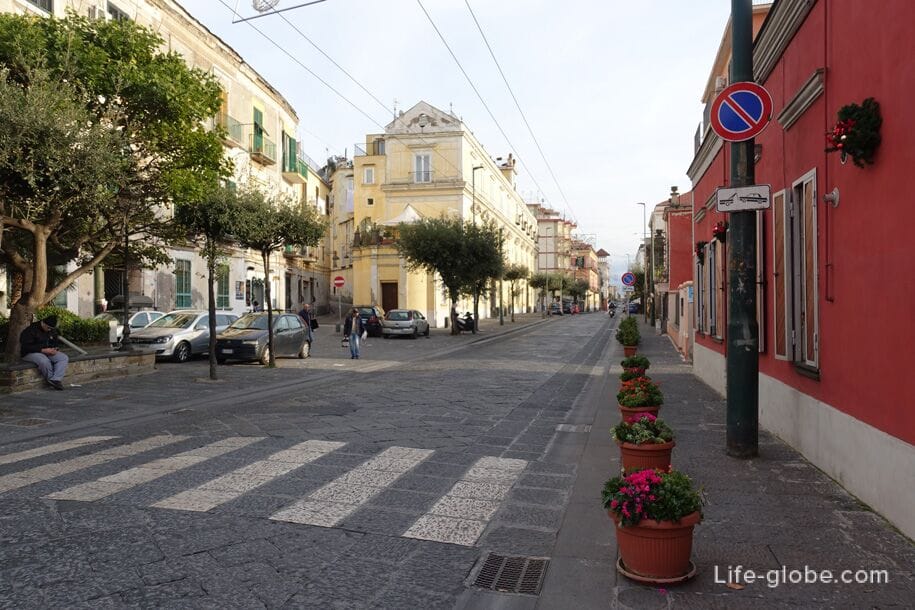
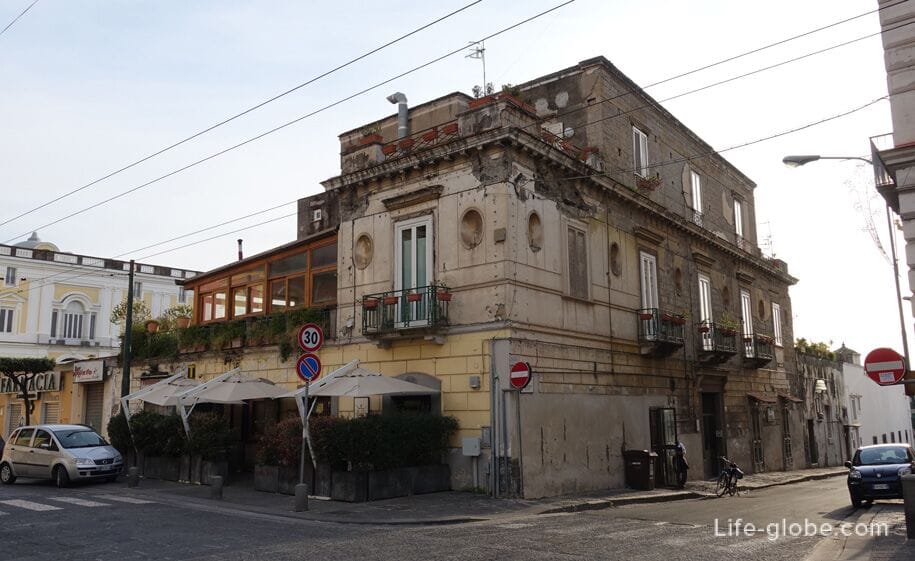
Volcanic coast Ercolano consists mostly of black lava rocks of different shapes and sizes.


In Ercolano there are a few small areas of well-maintained beach with dark volcanic sand beach, Arturo (Arturo Lido) located on the border of Herculaneum and Portici; Antico bagno a Favorite or a Favorite beach (Antico Bagno Favorita / Angels Club), and Lido near the border with the town of Torre del Greco and the beach is a 4-star Hotel Punta Quattroventi with stone coast and is equipped with descent to the sea.

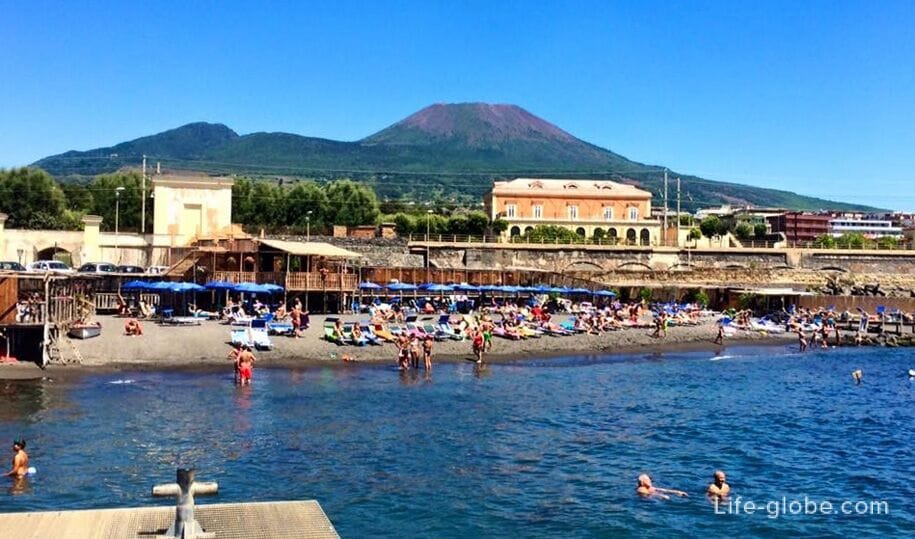

The coast of the neighboring town of Torre del Greco bole landscaped and is better suited for a beach holiday. Hotels in Torre del Greco
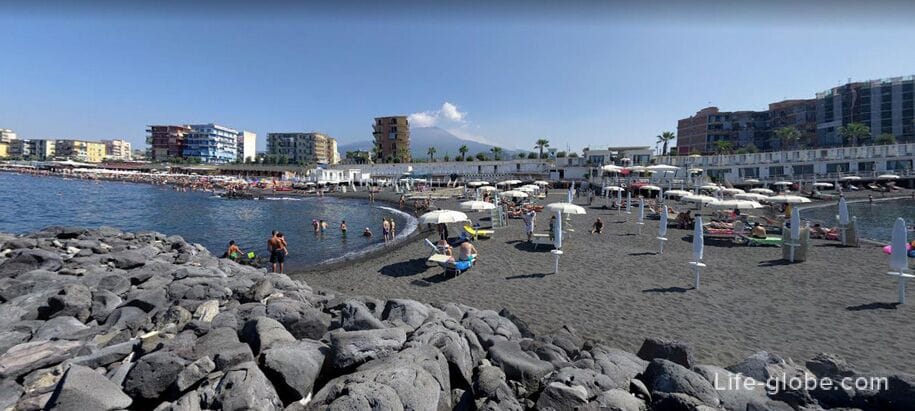
The Streets Of Ercolano
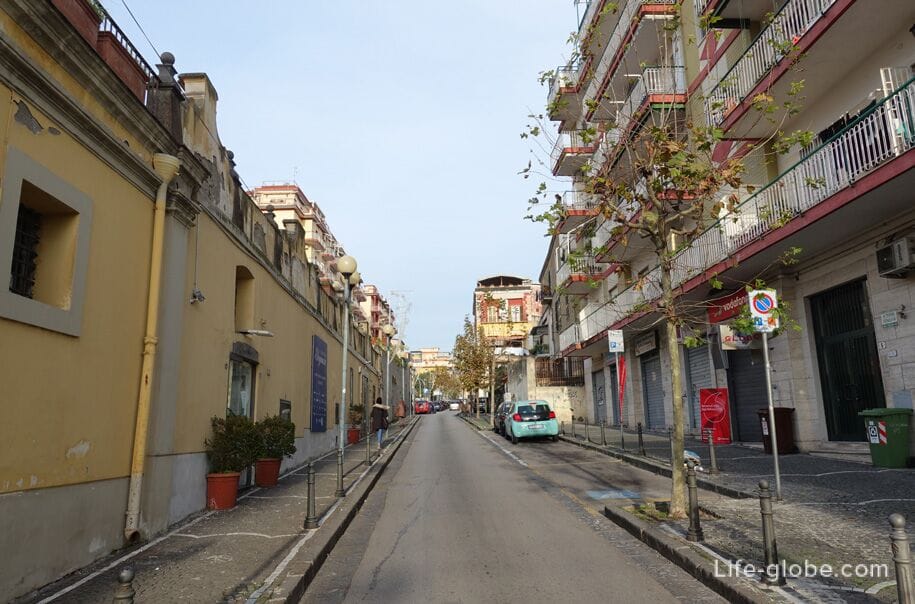
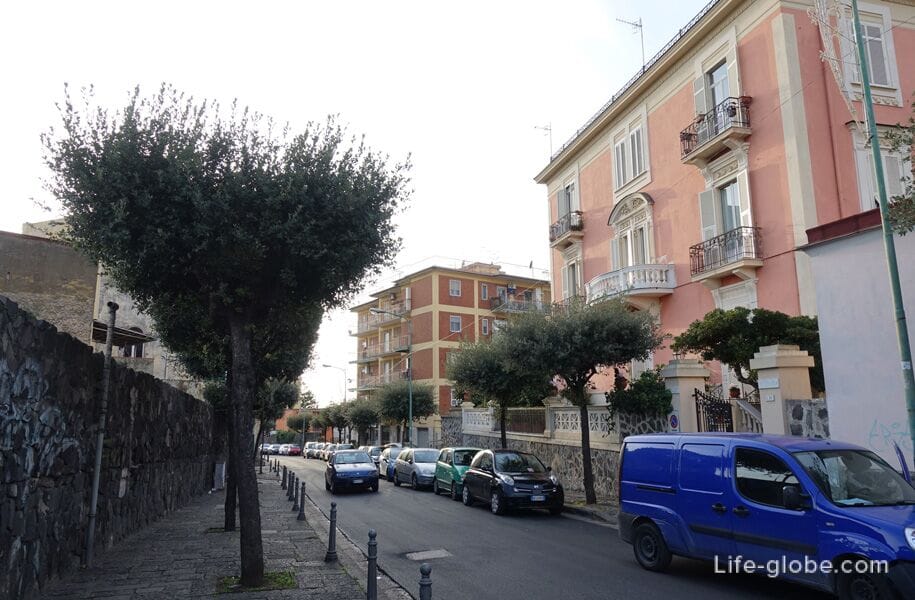
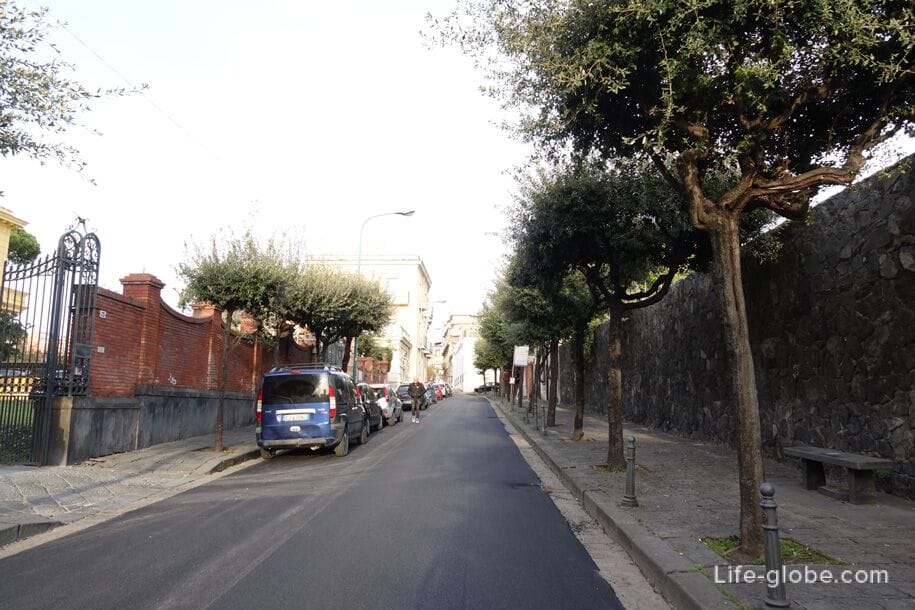
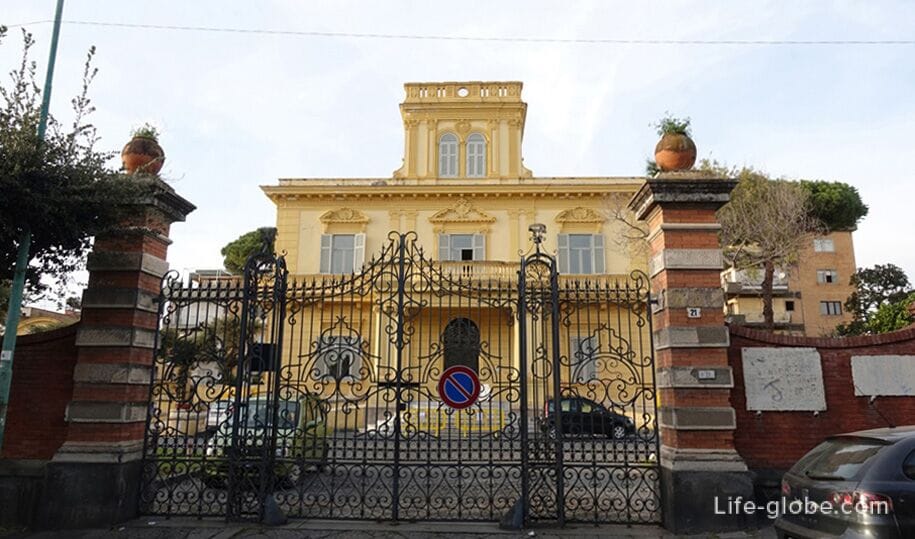
Benches on the streets with the emblem of Ercolano

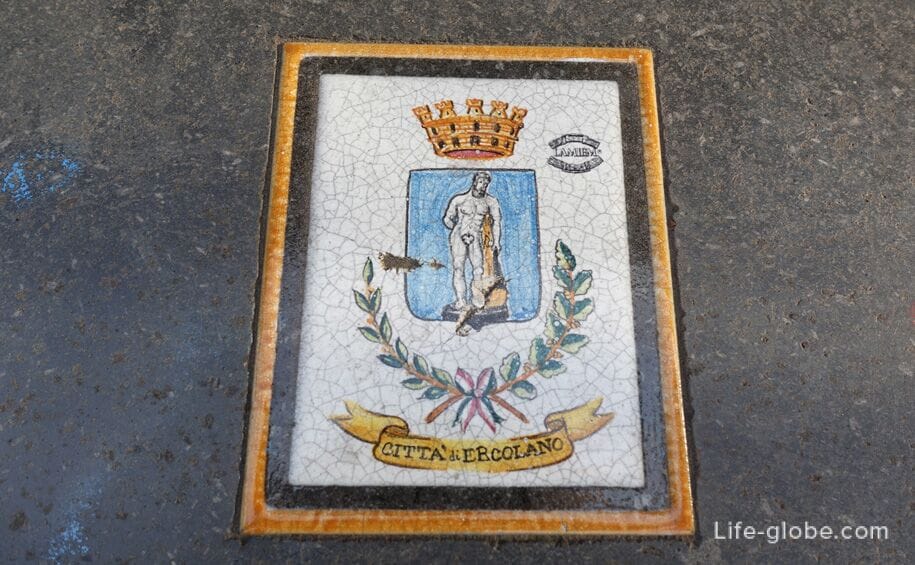
Majestic Vesuvius
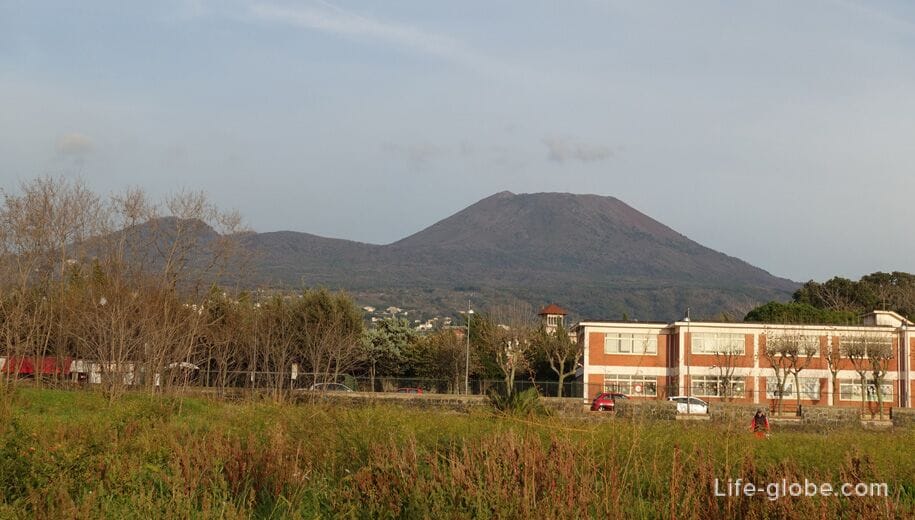
Tourism is not main source of income of local residents. Despite the presence of accommodation facilities in the city, the archaeological excavations of Herculaneum, as well as proximity and convenience to reach Vesuvius - Ercolano still remains a place for day visits by tourists staying mainly in Naples or Sorrento.
However, some of the guests still decide to stay in the commune for a few days and get to know the area, visiting the mount Vesuvius and the archaeological Park of Herculaneum.
All accommodation (hotels, guest houses, apartments, etc.) in Herculaneum and the surrounding area to see and book here
All means of accommodation in Sorrento you can view and book here
All accommodation facilities in Naples can view and book here
Ercolano nearest airport is the Napoli - Capodichino airport (Aeroporto Internazionale di Napoli - Capodichino). Cheap flights to Naples...
To get from Naples to Ercolano you can:
- by car from any point of Italy, car rental...
- by taxi, as from Naples airport and city centre
- by train from Naples and Sorrento to railway stations:
1. Ercolano scavi Ercolano (Ercolano Scavi) is the closest to archaeological Park and city center, the distance from the station to the Park is around 550 meters.
On this station there arrive trains of the company Ente Autonomo Volturno destinations such as Sorrento and Sarno. From Naples depart from the railway station Port Nolana (Porta Nolana), passing the Napoli Garibaldi station (Napoli Garibaldi). In the high tourist season at the Garibaldi station there are no free seats in the train. The ticket costs 2,20 Euros one way. Tickets can be purchased at the stations. Site.
Also in Ercolano has a railway station Miglio D'oro, but it is located a little further from the town centre and the archaeological Park.
Photo station Port Nolana in Naples
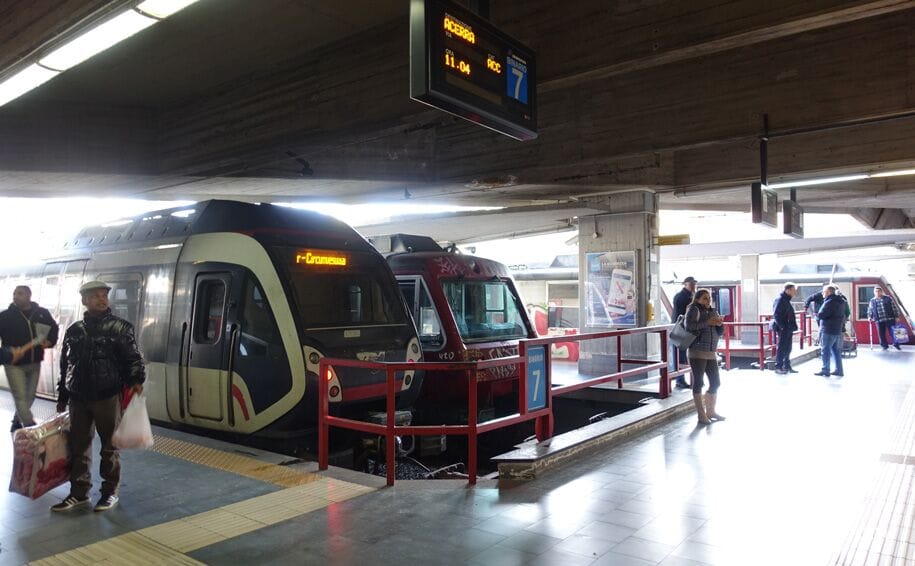
2. Portici - Ercolano (Portici - Ercolano), which is located near the sea, in the nearby town of Portici, on the distance about 1.7 km from the Park of Herculaneum.
At this station arrive trains Trenitalia. From Naples leave from several railway stations: Napoli Campi Flegrei and Napoli Piazza Leopardi, Napoli Mergellina, Napoli Piazza Amedeo, Napoli Montesanto, Piazza Cavour (Piazza Cavour), Piazza Garibaldi Napoli (Napoli Piazza Garibaldi) is located under the station Centrale and Napoli Gianturco, Napoli S. Giovanni Barra. Ticket price 1,60 Euro. Tickets can be purchased at the ticket office and vending machines at the stations and also online. Site.
Photo station of Portici-Ercolano, near the Granatello Marina
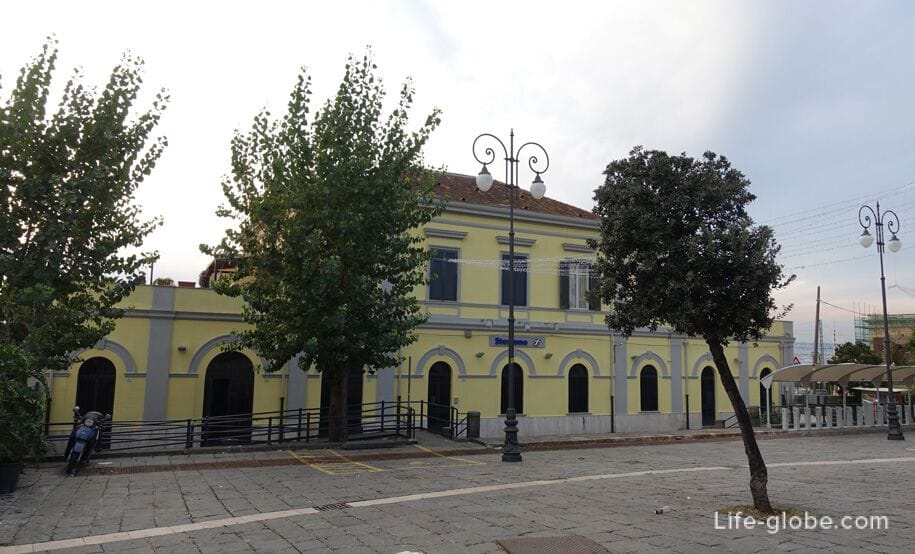
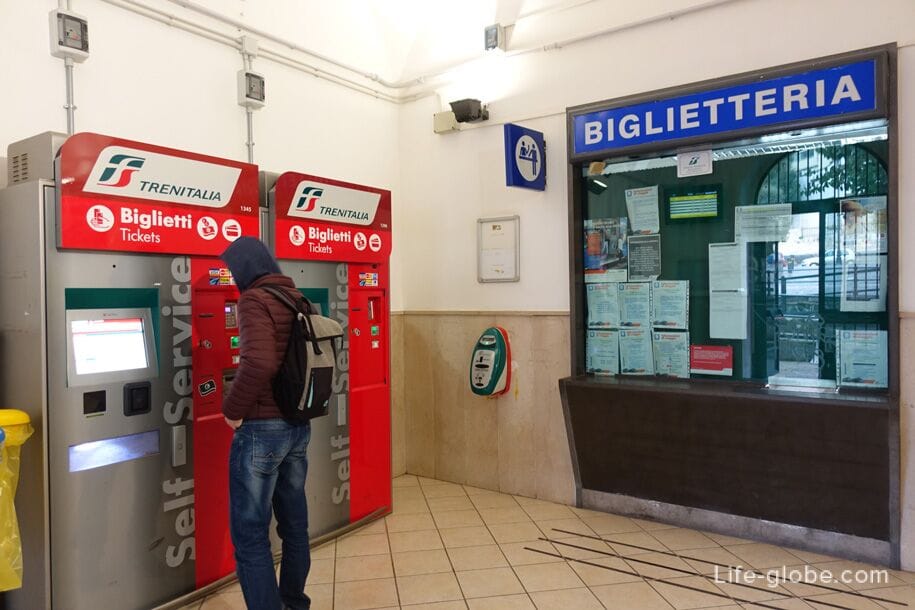


Italy belongs to the Euro zone because the country's currency is the Euro (€). Payment is accepted in cash and Bank cards in many shops, cafes and restaurants.
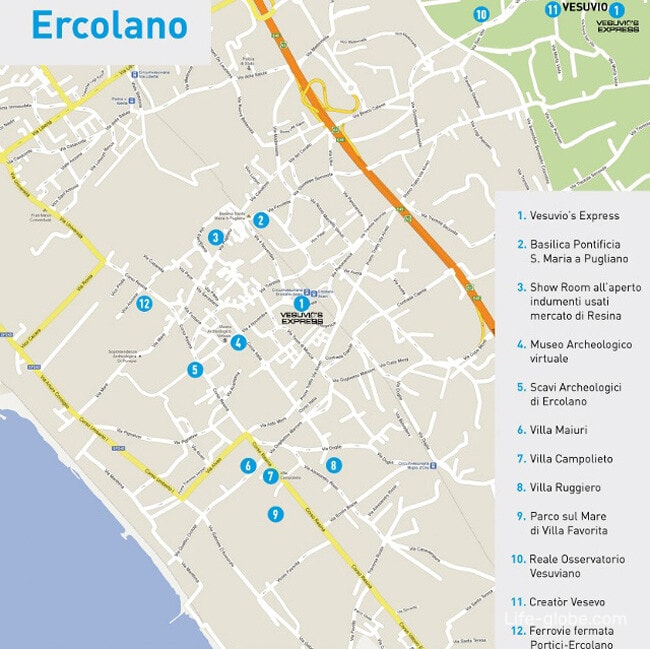
According to the legend, Herculaneum was founded by Hercules, returning from one of his twelve labors. Historically, the city likely was founded osanami, italic tribe of the 8th century BC, and later became part of the Etruscan and samnite dominions. Under the control of the Romans the city was a renowned seaside resort where some of the richest Roman citizens spent their summer vacation.
February 5, 62 ad Herculaneum was badly damaged by earthquakes. Rehabilitation projects were still in progress while was interrupted by another scourge - 24 August, 79 violently erupted and mount Vesuvius completely buried the small city under the 20-meter layer of volcanic rocks.
After the eruption the area was slowly settled, and in 121 year, probably, already had the old coastal road from Naples to Nocera. The first record of the existence of a village named Resina or Resina belong to the 10th century. The main business of the inhabitants of the Resin were: agriculture, fishing (also a collection of corals together with the inhabitants of the neighbouring town of Torre del Greco) and carving the volcanic stone.
In 1631, mount Vesuvius violently erupted after a long era of peace by destroying the area around it, killing more than 4,000 people and again changing the landscape of the area. It was the second most devastating eruption of the volcano.
After about three centuries of feudal subordination, the neighboring Resina and Portici, Torre del Greco and San Giorgio-Cremano freed from baronial status paying 106,000 ducats (and more than 2500 additional cost) in the property of the Crown as ransom. Baronial Ransom (Baronial Ransom) - one of the most memorable events in the history of the Resin and the neighboring small towns.
In 1709 the Duke Emmanuel Maurice, building his residence on the coast of Portici, he learned about the man who discovered the ancient columns, while digging a well in the nearby town of Resina. The Duke bought the farm and started to dig underground pits and galleries, which have unearthed statues, columns and marbles used to decorate his residence in Portici, and gave them as gifts to your friends, relatives, and monarchs throughout Europe.
News of the finds reached the king of Naples Charles VII, who, realizing the importance of the finds, bought a farm of the Duke and began a methodical campaign of excavation for the extraction of all underground riches. At the same time, the news of the discovery of the ancient Herculaneum has spread throughout Europe and stimulated a cultural movement called Neoclassicism, and has also attracted fans of the custom "Big tour" (Grand Tour) among British and European upper-class.
Inspired by the great number and beauty of the archaeological finds, the king built a summer Palace of Portici, on the border with Resinol. Finds of Herculaneum were placed in part of the Palace is open to guests of the king. The size of the collection increased particularly after 1750, when the earth exploration-a country Villa of the Pisoni family revealed a large number of wooden and marble statues.
Of particular importance was the discovery of 1752 of the burnt papyrus scrolls of the library of the Villa, known today as the Villa dei Papiri (remains of a Villa located in the Park of Herculaneum). The scrolls contained the valuable work of the ancient Greek philosopher Filedemo.
Following the example of the king, the nobles of the Kingdom began to build their summer villas and gardens next to the Royal Palace and in the surroundings. In that period were built large and representative Villa. This part of the street known as the Golden Mile (Miglio d'oro ).
In 1799, in the last days of the Neapolitan Republic in the streets of the Resin and Portici was the final battle between supporters of the king and the Republicans. To celebrate the return of the king of Naples Ferdinand IV against the "atheist" and Pro-French Republic, the inhabitants of the Resin of gratitude built the chapel with the crucifix, which replaced the Republican Tree of liberty. June 27, 1802, the king returned to Naples, moored to the pier of Villa Favorita.
Together with the construction of the first Italian railway in 1839 along the coast was established some industrial facilities (glassworks, tanneries, manufacture of railway wagons, etc.), once and forever changed the old view of the city. However, the resin remained an agricultural town, famous for its fruit and healthy air, and was a famous place of visit to the underground Theatre of Herculaneum and climbing to the crater of Vesuvius.
In 1845 was opened Real Oservatore of Vesuviano (Royal Observatory of Vesuvius), the first in the world.
In 1865 the king of Italy Vittorio Emanuele II was opened by the excavations of Herculaneum under the open sky.
In 1880 was opened the funicular on mount Vesuvius. The funicular was repeatedly destroyed in the eruption of the volcano and was decommissioned after the eruption of 1944.
The second oldest Italian motorway was opened in 1930 from Naples to Pompeii, departing in resin.
February 12, 1969, at the official request of the city Council the President of the Italian Republic decided to return the historical name of the city and change it with Resin to Ercolano.
In 1971, the Fund was established Ente per le Ville Vesuviane, whose goal is the restoration and preservation of the main villas of the 18th century.
In the 1980's and 1990's, the city suffered from industrial crisis with the sharp rise in unemployment and crime. Since then, the activities in Ercolano aimed at accelerating socio-economic growth, based on tourist and cultural activities.
In 1995 was created the Parco Nazionale del Vesuvio (the national Park of mount Vesuvius), and the entire area of Ercolano North of motorway was included in the Park.
In 1997 the archaeological site of Herculaneum, together with Pompeii, was inscribed on the world heritage list of UNESCO.
In 2005, in conjunction with the opening of the virtual archaeological Museum was opened a permanent exhibition under the open sky "Creator Vesevo" with 10 stone sculptures of contemporary famous international artists, exhibited on the slopes of Vesuvius.